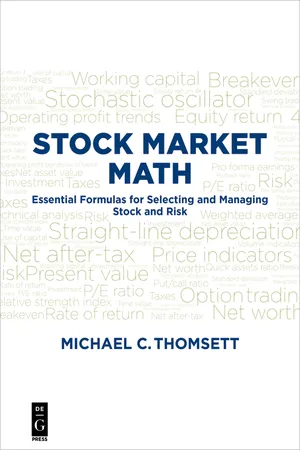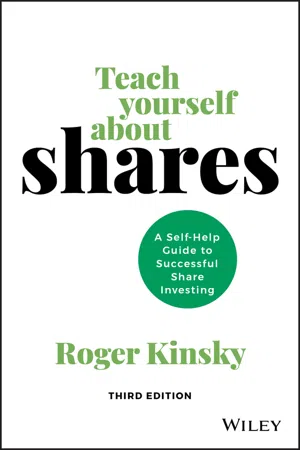Business
Investment Returns
Investment returns refer to the financial gains or losses generated from an investment over a specific period of time. It is typically expressed as a percentage and reflects the performance of the investment. Positive returns indicate a profit, while negative returns signify a loss. Understanding and analyzing investment returns is crucial for evaluating the success of investment strategies and making informed financial decisions.
Written by Perlego with AI-assistance
Related key terms
4 Key excerpts on "Investment Returns"
- eBook - ePub
- Erik Lie(Author)
- 2023(Publication Date)
- Business Expert Press(Publisher)
CHAPTER 2 Investment Returns and Investment PrinciplesAs an individual investor, you have access to many different types of investments, ranging from education (which is an investment in your human capital) to shares in publicly traded companies (i.e., stocks). What matters for investors is the return over time from those investments. This chapter reviews the calculation and behavior of returns. The focus is on returns on investments in stocks and bonds, which form the basis for much of our wealth accumulation, while later chapters cover real estate and various insurance products.The main objectives for this chapter are:• Explore Investment Returns of stocks and bonds, including how returns behave across securities and time.• Learn some basic investment principles based on the aforementioned exploration, including the benefits of:Diversification across many securities; andInvesting in riskier securities for longer investment horizons.Investment ReturnsFigure 2.1 shows the calculation of the return on investment. This investment return can be highly uncertain, and we often refer to that uncertaintyas volatility and measure it with standard deviation. Importantly, most of the volatility stems from the first part of the investment return, that is, the capital gain. The second part, that is, the return from capital distributions, is much more stable and predictable in practice.Figure 2.1 Calculation of investment returnFigure 2.2 The sources of returns for bonds and stocksThe relative magnitudes of the two sources of returns, capital gains and distributions, differ greatly across securities, as illustrated in Figure 2.2 - eBook - ePub
- Michael C. Thomsett(Author)
- 2017(Publication Date)
- De Gruyter(Publisher)
Chapter 1 Rates of Return on Investment: What Goes In, What Comes Out Even the most seemingly easy calculation can become quite involved.For example, what is your “return?” If you invest money in a stock or mutual fund, you need to be able to figure out and compare the outcome; but as the following explanation demonstrates, there are many different versions of “return” and you need to be sure that when comparing two different outcomes, you are making a like-kind study. Otherwise, you can be deceived into drawing an inaccurate conclusion. And accuracy is one of your goals in going to the trouble of drawing conclusions in the first place.The “return” you earn on your investments can be calculated and expressed in many different ways. This is why comparisons are difficult. If you read the promotional literature from mutual funds and other investments, the return provided in the brochure could be one of many different results.This is why you need to be able to make distinctions between return on investment and return on capital . Your investment return is supposed to be calculated based on the amount of cash you put into a program, fund or stock. Most investors use “return on investment” in some form to calculate and compare. The return on capital is usually different and is used by corporations to judge operations. To further complicate matters, “capital” is not the same as “capitalization” so corporate return calculations can be difficult to compare. Return on capital normally means capital stock. Capitalization is the total funding of an organization, including stock and long-term debt.A business model of return on capital may present problems, however. Accuracy is in question when the calculation is based on a fixed value, such as capital, versus current value of the same investment: - eBook - ePub
Teach Yourself About Shares
A Self-help Guide to Successful Share Investing
- Roger Kinsky(Author)
- 2020(Publication Date)
- Wiley(Publisher)
inflation‐adjusted return. It's what you're really getting in terms of purchasing power.For instance, suppose you're receiving an after‐tax return of 3% on an investment at a time when the inflation rate is also 3%. This means that your real return is zero and your wealth isn't growing. Indeed, the capital you've invested is just marking time. However, if your return on capital is 3% before tax and you have to pay tax on the profits, then your real return after tax is negative and, in fact, your wealth is reducing rather than increasing.Considering investment risks
It's important to consider the risks involved with any investment because risk and return are fundamentally related. Share investing risks are treated in detail in chapter 13 but I'll introduce the basics now.Risk applies to both capital gains and income.Capital gains risk
This is the risk that your investment may not increase in value and, rather, could reduce. The very worst‐case scenario is that you could lose all the money you've invested; that is, you lose all your invested capital.Income risk
This is the risk that your investment may not produce the expected income. For example, with an investment property, it's the risk that the tenant may default on rental payments; with shares, it's the risk that if company profits reduce, the directors may decide to reduce (or eliminate) the dividend.Relationship between risk and return
A general principle that applies to all investments is that investors relate risk and return in the following way:Or expressed another way:The higher the perceived risk, the greater the potential return.The lower the perceived risk, the lower the potential return.I use the word perceived with risk because it depends on investors' perceptions of riskiness and this may not necessarily reflect the real risk. And I use the word potential - eBook - ePub
Forbes Guide to the Markets
Becoming a Savvy Investor
- Marc M. Groz(Author)
- 2009(Publication Date)
- Wiley(Publisher)
Section SixSumming Up Risk and ReturnSUMMING UP RISK AND RETURN
In the preceding sections we have learned a great deal about financial investments and their markets. No guide to the markets would be complete, however, unless it addresses how to evaluate investment results. Though this is a large and complex topic, it boils down to an understanding of how investment results (referred to as Investment Returns or performance ) are measured and reported, both in absolute terms and after adjusting for risk.Chapter Nineteen provides an introduction to the ways that performance is calculated and to the standards used by investment managers for presentation of performance results to clients and prospects. Chapter Twenty introduces the concept of investment risk and explains some of the ways it can be measured, or at least estimated. It concludes with some guidelines for applying an understanding of risk to the investment process. Finally, in Chapter Twenty-one, we take a step back to the larger context of the financial markets, offering some final thoughts.Passage contains an image
Chapter 19HOW WELL ARE MY INVESTMENTS DOING?Measuring Investment ResultsThere are many ways to measure the results of your investing activities. You may have heard about the high performance of a particular mutual fund, or that a certain stock has a good return on equity (ROE) or return on investment (ROI). All of these have some bearing on the measurement of investment results. But right now, we are more concerned with a more personal aspect of return: How can you calculate the return on your money?performanceMeasure of return as proportion of original investment, or measure of investment performance in an average period.Figuring out the return on your money can be a difficult and time-consuming task. Most of the difficulty is of the grunt-work variety. You may have to track down all the pieces of paper that tell what happened when. Some of the difficulties are interesting and can lead to a deeper understanding of the investment process.
Index pages curate the most relevant extracts from our library of academic textbooks. They’ve been created using an in-house natural language model (NLM), each adding context and meaning to key research topics.



